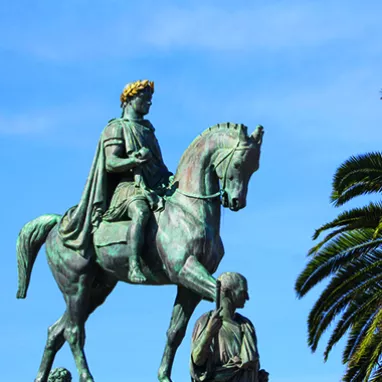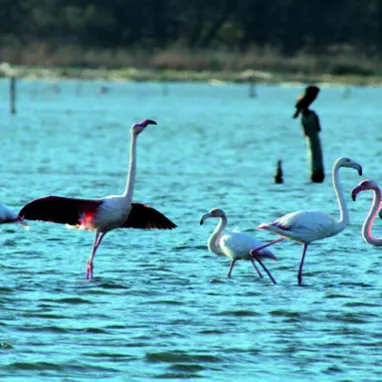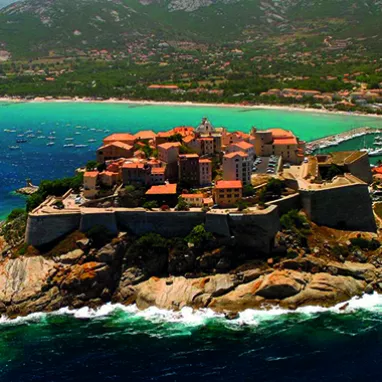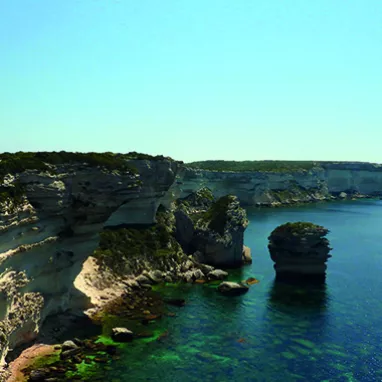Museums in Corsica
Corsica also tells its story through its museums. It is a wonderful way to explore our island all year round, traveling from one region to another, discovering permanent collections or temporary exhibitions. A journey through time, spanning ten thousand years of history, from the Mesolithic period to the present day, not to mention the island's two great legends: Pascal Paoli and Napoleon.
Ajaccio & South Corsica
Ajaccio
1 - Palais Fesch, Musée des Beaux-Arts
The majority of the museum’s collection comes from the legacy of Cardinal Fesch, uncle of Napoleon I. Additional donations and bequests have since enriched the museum’s core collection. Beyond the 1,500 works of art, including part of the original furniture and a statue of Napoleon as First Consul, the Palais Fesch, Musée des Beaux-Arts, houses one of the most important collections of Italian painting in France: Italian Primitives, Roman Baroque painting, Neapolitan Baroque painting, Flemish school paintings, a Napoleonic collection, and a Corsican painting collection.
2 - The Imperial Chapel
The chapel, built with stones from Saint-Florent, was one of the cardinal’s final wishes. He now rests there alongside Napoleon I’s parents and other members of the imperial family. Built in a neo-Renaissance style, it is located in the right wing of the Palais Fesch. The stained glass windows are adorned with the "F" for Cardinal Fesch, and visitors can admire many religious features with imperial symbols such as the Eagle and the Legion of Honour.
Practical information:
- Open from November 1 to April 30: every day from 9:00 a.m. to 5:00 p.m.
- From May 1 to October 31: every day from 9:15 a.m. to 6:00 p.m.
- Annual closure: January 1 to January 16. Closed on December 25 and January 1.
- The Imperial Chapel is open only in summer.
- Admission: Full price: €8 - Reduced price: €5 - Group price: €5 - Loyalty card: €30.
- Access: 50-52 rue Fesch, 20000 Ajaccio - +33(0)4 95 26 26 26 - Palais Fesch, Musée des Beaux-Arts.
3 - Napoleonic Salon Museum
Statues, souvenirs, and objects from the Napoleonic epic and the imperial family are preserved at the Napoleonic Museum, located in the heart of the Ajaccio Town Hall.
Practical information:
- Access: Ajaccio Town Hall, Place Foch, 20000 Ajaccio
- Entrance: Open to all
- Opening hours: Please check current schedules.
4 - National Museum of the Bonaparte House
Napoleon was born in this house on August 15, 1769. The furniture, paintings, tapestries, and portraits immerse visitors in the atmosphere of the imperial reign, from Napoleon’s birth to his death, while also offering insight into the private family life of the emperor. Notably, agricultural tools can be seen in the house’s cellars, referencing the Bonaparte family's former status as landowners.
Practical information:
- Open from October 1 to March 31: 10:30 a.m. - 12:30 p.m. / 1:15 p.m. - 4:30 p.m.
- From April 1 to September 30: 10:00 a.m. - 12:30 p.m. / 1:15 p.m. - 5:30 p.m.
- From August 1 to August 31, 2023: 10:00 a.m. - 5:30 p.m.
- Access: Rue Saint-Charles, 20000 Ajaccio
- Contact: +33(0)4 95 21 43 89 - maison.bonaparte@culture.gouv.fr - National Museum of the Bonaparte House.
Bastia & Upper Corsica
Aleria
Jérôme Carcopino Archaeology Museum
The Jérôme Carcopino Museum displays the remains discovered at the archaeological site of Aleria. Housed in Fort Matra, built in the 14th century, visitors can admire objects unearthed during excavations of the ancient colony and necropolises. Fort Matra was classified as a historical monument in 1962. On the first floor, several exhibition rooms are dedicated to Aleria and Corsican history over fifteen centuries, from protohistory to the end of the Roman Empire.
Practical information:
- Open from October 1 to May 15: 9:00 a.m. to 5:00 p.m.
- From May 16 to September 30: 10:00 a.m. to 6:00 p.m.
- Closed on Sundays.
- Admission: Full price: €4 - Reduced price: €3
- Access: Fort de Matra, 20270 Aleria – Jérôme Carcopino Archaeology Museum.
Bastia
Bastia Museum – Palace of the Governors
This is the only example of a Genoese palatine fortress in Corsica, converted into a museum in 1950 to tell the story of Corsican ethnography. The view between the sea and the mountains is absolutely remarkable. Completely renovated since 2010, the Bastia Museum highlights the sovereignty of the Republic of Genoa in Corsica. The permanent collections present paintings, sculptures, artifacts, and furniture, offering a journey through seven centuries of the history of Bastia and Corsica. A temporary exhibition is also presented each year to revisit or highlight Corsica’s architectural and cultural heritage. The site also hosts events such as the Festival Creazione – Art, Fashion, and Design, which takes place every June.
Practical information:
- High season: Open from May 2 to September 30 from 10:00 a.m. to 6:30 p.m.
- Open every day in July and August.
- Closed on Mondays in May, June, and September.
- Low season: Open from October 1 to April 30 from 9:00 a.m. to 12:00 p.m. and from 2:00 p.m. to 5:00 p.m.
- Closed on Sundays and Mondays.
- Closed on November 1 and 11; May 1 and 8; and during the Christmas school holidays.
- Access: Bastia Museum, Place du Donjon, The Citadel, 20200 Bastia.
- Contact: +33 (0)4 95 31 09 12 – musee-bastia@bastia.corsica – Bastia Museum – Palace of the Governors.
Lucciana
Mariana Archaeological Museum – Prince Rainier III of Monaco
In a contemporary setting, visitors can travel back in time to discover an exceptional archaeological collection, offering a journey through the Marana plain from the Bronze Age to the present day. Opened in 2021, the Mariana Museum is also a center for scientific research, combining study, conservation, and public education. For visitors, the museum features a modern building where the grand staircase connects two levels and offers an impressive interior/exterior panorama. The highlight is the terrace – a belvedere offering a breathtaking view of both the sea and the mountains. An educational workshop for young visitors helps create a connection between the laboratory and the archaeologists.
Practical information:
- Admission: Full price: €7 – Reduced price: €4
- Access: Archaeological Site Museum of Mariana – 10 strada di U Granalese, Lieu-dit Canonica, 20290 Lucciana.
- Contact: +33 (0)4 20 19 02 40 – musee@mariana-lucciana.fr – Mariana Archaeological Museum – Prince Rainier III of Monaco.
Calvi & the Balagne
Calvi
Guy Savelli Private Museum
This history enthusiast has been sharing the story of Corsica and the Balagne region since 1990 through an impressive collection of ancient objects: portraits, posters, maps, letters, musical instruments, books, drawings, 16th, 17th, and 18th-century paintings, parchments... A treasure trove completed by a series of traditional Corsican knives, pistols, and coins. A truly unique and precious experience. Located about 7 km from Île-Rousse and 23 km from Calvi.
Practical information:
- Open from April 15 to September 30
- From April to June: 3:00 p.m. to 6:00 p.m.
- From July to September: 4:00 p.m. to 7:00 p.m.
- Closed on Sundays
- Guy Savelli Private Museum – Place de l’Église – 20220 Corbara
- Contact: +33 (0)4 95 60 06 65 – Guy Savelli Private Museum.
Figari & the Far South
Bonifacio
Centre Pompidou
For the first time in Corsica, see one of the most beautiful collections of modern and contemporary art on the island. The exhibition La Notte presents 13 works by artists inspired by the Mediterranean.
Practical information: From June 29 to September 29, 2023 – Open every day from 10:00 a.m. to 8:00 p.m. except Saturdays.
Access: De Renava off Centre Pompidou – Caserne Montlaur, 20169 Bonifacio
Rates: Full price: €7 – Reduced price: €5 – Centre Pompidou – Bonifacio Tourist Office.
Porto-Vecchio
Citadel Museum
Unique in France, the Citadel Museum presents a significant private collection that reveals the ingenuity and elegance of French craftsmanship: an exhibition of over 400 knives (from the Stylet to the Vendetta, including Navaja knives, voodoo sacrificial knives, and even a one-shot pistol-knife) as well as the history of the cane, from its origin to the Belle Époque, passing through the Middle Ages.
Practical information:
- Open in April, May, and October from 10:00 a.m. to 12:30 p.m. & from 3:00 p.m. to 7:00 p.m.
- July, August: from 10:00 a.m. to 10:00 p.m.
- June to October: from 10:00 a.m. to 8:00 p.m.
Rates: Full price: €5 – Reduced price: €5
Access: Citadel Museum, 14 rue de la Citadelle, 20137 Porto-Vecchio
Contact: museedelacitadelle@gmail.com – +33 (0)4 95 20 81 74 / +33 (0)6 18 18 61 89 – Citadel Museum.
Sartène
Archaeological Museum
Collections characteristic of island archaeology from the first settlements 10,000 years ago to the end of the Genoese period in the 15th century AD. Explore Prehistory, the Bronze Age, and the Iron Age: ceramics, weapons, jewelry, tools, etc. Admire the statue-menhirs, emblematic of Corsican and Mediterranean megalithic culture.
Practical information:
- Open from April 1 to May 31: Tuesday to Saturday from 10:00 a.m. to 5:00 p.m.
- From June 1 to October 31: every day from 10:00 a.m. to 6:00 p.m.
- From November 1 to March 31: Monday to Friday from 9:00 a.m. to 4:00 p.m.
- Closed on public holidays
Access: Musée d'archéologie de la Corse, Boulevard Jacques Nicolai, 20100 Sartène
Rates: Full price: €4 – Reduced price: €3
Contact: +33 (0)4 95 77 01 09 – musee.sartene@isula.corsica
Levie
Museum of Alta Rocca
Discover the Land of the Lords, one of the most beautiful regions of Corsica. Reflecting 10,000 years of history, the collections presented at the museum provide a precise image of daily life in Alta Rocca from the 8th millennium BC to the Middle Ages. The displayed remains are a true archaeological reference, notably The Lady of Bonifacio, the oldest human remains discovered in Corsica. Also available: conferences, symposiums, theater, concerts, literary events, and temporary exhibitions.
Practical information:
Access: Musée de l'Alta Rocca – Quartier Pratu, 20170 Levie
Contact: +33 (0)4 95 78 00 73 – levie.musee@isula.corsica – Musée de l'Alta Rocca.
Corte & Central Corsica
Corte
1 - Museum of Corsica
Opened in 1997, the Museum of Corsica is a cultural space dedicated to discovering Corsican culture and its territory. Nestled in the heart of Corte’s famous citadel, the site spans both neoclassical and contemporary architecture. The Doazan Gallery, created by Father Louis Doazan, presents the island's heritage organized around four main themes: "Discovering Corsica," "Craftsmanship and Know-How," "The Milisaria Sheepfold," and "The Shepherd's Space." Nearly three thousand traditional Corsican objects are exhibited here. The "Museum in Progress" halls offer visitors rooms dedicated to Traditional and Industrial Corsica, Entrepreneurship in Corsica, the adoption of new technologies, the revival of religious brotherhoods, and Tourism in Corsica. Another space is devoted to temporary exhibitions, renewed each year to offer visitors a different perspective on Corsica depending on the chosen theme.
Temporary Exhibitions
Cartografia, Corsica in Maps 1520 - 1900: This exhibition brings together a selection of ancient documents, maps and plans, books, and atlases to offer a different way to explore Corsica. Nearly 300 works are presented to the public from July 29 to January 31, 2024.
Practical information:
- Open every day from 10:00 a.m. to 7:00 p.m.
- Access: Museum of Corsica, La Citadelle, 20250 Corte
- Contact: +33 (0)4 95 45 25 45 – museudiacorsica@isula.corsica – Museum of Corsica.
2 - FRAC Corsica
Since 1986, the FRAC Corsica (Regional Fund for Contemporary Art) has assembled and managed an international contemporary art collection of 523 works. It is the second-largest public art collection in Corsica after the Palais Fesch, the fine arts museum in Ajaccio. Strongly engaged with the environment, territory, and identity, FRAC Corsica gives an important place to Corsican artists to promote its core values. Exhibitions are regularly organized, often moved "outside the walls" to make them accessible throughout Corsica.
Practical information:
- Open from February to May and from September to December, Monday to Saturday from 10:00 a.m. to 5:00 p.m.
- From June to September, open Tuesday to Saturday from 10:00 a.m. to 6:00 p.m.
- Closed on December 25, January 1, and May 1
- Free entrance
- Access: La Citadelle, 20250 Corte
- Contact: +33 (0)4 20 03 95 33 – frac@isula.corsica – FRAC Corsica.
Morosaglia
Birthplace of Pascal Paoli
Pascal Paoli, born in 1725, spent his entire childhood in this house. Since 1954, this rural notables' residence has housed the museum dedicated to the "Father of the Nation." Founder of the first Corsican constitution in 1755, which established the sovereignty of the people, Pascal Paoli was the first to provide the island with an army, a navy, an administration, a justice system, a currency, and a printing press. He is also credited with the creation of Corsica’s first university, founded in Corte in 1765. Closed four years later due to historical events, it was reopened in 1981 in Corte thanks to a popular movement. The second floor is entirely dedicated to the "General of the Corsican Nation," with four rooms showcasing his life, including furniture, personal belongings, and portraits of the great man. On the ground floor, the funeral chapel preserves Pascal Paoli's ashes, brought back to Corsica on September 4, 1889, as well as the tombstone that originally adorned his grave at St. Pancras Church cemetery in London, where he died in 1807.
Practical information:
- Open from October 1 to May 15: Monday to Saturday from 10:00 a.m. to 5:00 p.m.
- From May 16 to September 30: Tuesday to Sunday from 10:00 a.m. to 6:00 p.m.
- Access: Pascal Paoli Departmental Museum, Hamlet of la Stretta, 20218 Morosaglia
- Prices: Full rate €4 – Reduced rate €3 – Free for children under 10
- Contact: +33 (0)4 95 61 04 97 – Birthplace of Pascal Paoli.
Archaeological sites
Aleria
Archaeological Site – Historical Monument
An ancient Greek colony, Aleria was the capital of Roman Corsica during Antiquity and spans 8,000 years of history. The path leading to the site offers an incredible view over Aleria and the Tavignano River. Excavations have uncovered the forum and the foundations of the main monuments of the ancient Roman city.
Practical information:
- Open from October 1 to May 15: 9:00 a.m. to 5:00 p.m.
- From May 16 to September 30: 10:00 a.m. to 6:00 p.m.
- Closed on Sundays
- Rates: Full price: €4 – Reduced price: €3
- Contact: Archaeological Museum, 20270 Aleria – +33 (0)4 95 46 10 92 – Aleria Ancient Site.
Sartène
Megalithic Site of Cauria
Granite megalithic monuments, known as "I Stantari" and "Rinaghju," bear witness to the occupation of this area since the Neolithic period. A funerary monument called "Funtanaccia," located at the top of a natural hill, once paid tribute to the deceased.
Practical information: Megalithic Site of Cauria.
Filitosa
This is Corsica’s most iconic prehistoric site: Filitosa has guarded its statue-menhirs and the mystery surrounding them for 8,000 years. Listed as a Historic Monument, Filitosa is an incredibly beautiful place with a perfectly preserved natural environment in the heart of wild olive trees, Corsican oaks, and fragrant maquis.
The site is about 16 km from Sartène.
Practical information:
- Access: Prehistoric site of Filitosa, 20140 Sollacaro
- Contact: +33 (0)4 95 74 00 91 – contact@filitosa.fr – The Prehistoric Site – Visit the Filitosa site.
Levie
Archaeological Site of Cucuruzzu and Capula
Discovered in the 1970s, the Cucuruzzu site houses a protohistoric village dating back to the Early Bronze Age around 1800 BC. Classified as a Historic Monument and listed as a UNESCO World Heritage site, this location invites you to travel back in time. Cucuruzzu and Capula are two remarkable sites that are easily accessible via a marked trail. The "Casteddu di Cucuruzzu" is a fortified dwelling, and the "Casteddu di Capula" is a medieval fortress – both are must-sees.
Practical information:
- Open from March 15 to October 31, 2023, from 9:00 a.m. to 6:00 p.m. – Last entry at 4:00 p.m.*
- From June to September: Open from 9:30 a.m. to 7:00 p.m. – Last entry at 5:00 p.m.*
- Allow about two hours for a full visit (3 km walk). Hiking shoes are strongly recommended.
- Rates: Full price: €4 – Reduced price: €3 (seniors, children and young adults 10–25 years old, students, groups of 10+ people, families); €2 for tour operators. Free admission with valid proof.
- Access: From Ajaccio, follow the T40 towards D263 Sartène, then follow signs to Levie. From Porto-Vecchio, take the D859/T40 then D59 towards Levie.
- Contact: +33 (0)6 13 35 94 67 – Cucuruzzu and Capula Archaeological Site – Alta Rocca Tourism.




